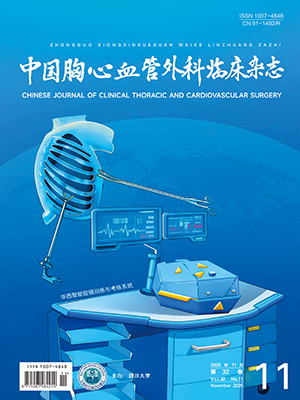| 1. |
肖小菊, 黎勵文. 《心力衰竭的通用定義和分類》解讀. 中國胸心血管外科臨床雜志, 2021, 28(10): 1140-1144.Xiao XJ, Li LW. Interpretation of the General Definition and Classification of Heart Failure. Chin J Clin Thorac Cardiovasc Surg, 2021, 28(10): 1140-1144.
|
| 2. |
Zhuang B, Shen T, Li D, et al. A model for the prediction of mortality and hospitalization in Chinese heart failure patients. Front Cardiovasc Med, 2021, 8: 761605.
|
| 3. |
Gao S, Yin G, Xia Q, et al. Development and validation of a Nomogram to predict the 180-day readmission risk for chronic heart failure: A multicenter prospective study. Front Cardiovasc Med, 2021, 8: 731730.
|
| 4. |
Shin S, Austin PC, Ross HJ, et al. Machine learning vs. conventional statistical models for predicting heart failure readmission and mortality. ESC Heart Fail, 2021, 8(1): 106-115.
|
| 5. |
Lin Z, Liu X, Xiao L, et al. The MELD-XI score predicts 3-year mortality in patients with chronic heart failure. Front Cardiovasc Med, 2022, 9: 985503.
|
| 6. |
Mortazavi BJ, Bucholz EM, Desai NR, et al. Comparison of machine learning methods with national cardiovascular data registry models for prediction of risk of bleeding after percutaneous coronary intervention. JAMA Netw Open, 2019, 2(7): e196835.
|
| 7. |
Christodoulou E, Ma J, Collins GS, et al. A systematic review shows no performance benefit of machine learning over logistic regression for clinical prediction models. J Clin Epidemiol, 2019, 110: 12-22.
|
| 8. |
李楊. 北京地區急性心力衰竭患者遠期生存狀況、獨立危險因素及其預測模型研究. 北京協和醫學院, 2021.Li Y. A study on the long-term survival outcomes, independent risk factors, and predictive models for acute heart failure patients in the Beijing region. Peking Union Medical College, 2021.
|
| 9. |
Cai A, Chen R, Pang C, et al. Machine learning model for predicting 1-year and 3-year all-cause mortality in ischemic heart failure patients. Postgrad Med, 2022, 134(8): 810-819.
|
| 10. |
Hung WK, Liu HT, Wang CC, et al. One-year mortality risk stratification in patients hospitalized for acute decompensated heart failure: Construction of TSOC-HFrEF risk scoring model. Acta Cardiol Sin, 2020, 36(3): 240-250.
|
| 11. |
Senni M, Parrella P, De Maria R, et al. Predicting heart failure outcome from cardiac and comorbid conditions: The 3C-HF score. Int J Cardiol, 2013, 163(2): 206-211.
|
| 12. |
Geersing GJ, Bouwmeester W, Zuithoff P, et al. Search filters for finding prognostic and diagnostic prediction studies in Medline to enhance systematic reviews. PLoS One, 2012, 7(2): e32844.
|
| 13. |
Moons KG, de Groot JA, Bouwmeester W, et al. Critical appraisal and data extraction for systematic reviews of prediction modelling studies: The CHARMS checklist. PLoS Med, 2014, 11(10): e1001744.
|
| 14. |
Wolff RF, Moons KGM, Riley RD, et al. PROBAST: A tool to assess the risk of bias and applicability of prediction model studies. Ann Intern Med, 2019, 170(1): 51-58.
|
| 15. |
陳春梅. 慢性心力衰竭患者1年內死亡的風險評估研究. 吉首大學, 2020.Chen CM. A study on risk assessment of mortality in patients with chronic heart failure within one year. Jishou University, 2020.
|
| 16. |
孫聰. 基于決策樹的慢性心力衰竭患者中西醫預后模型研究. 山東中醫藥大學, 2020.Sun C. A study on prognostic models for chronic heart failure patients based on decision trees: Integrating traditional Chinese medicine and Western medicine. Shandong Univeristy of Traditional Chinese Medicine, 2020.
|
| 17. |
單少鵬. 基于神經網絡與超聲心動圖的慢性收縮性心力衰竭預后模型研究. 山東大學, 2021.Shan SP. Research on prognostic models for chronic systolic heart failure based on neural networks and echocardiography. Shandong Univeristy,2021.
|
| 18. |
劉黎霞, 柳森, 謝東君, 等. 慢性心力衰竭預后生物標志物預測模型的建立. 中國臨床實用醫學, 2021, 12(6): 52-56.Liu LX, Liu S, Xie DJ, et al. Establishment of a prognostic biomarker model for chronic heart failure. China Clin Pract Med, 2021, 12(6): 52-56.
|
| 19. |
王穎川. 慢性心力衰竭患者90天再入院預測模型的建立. 右江民族醫學院, 2021.Wang YC. Development of a predictive model for 90-day readmission in patients with chronic heart failure. Youjiang Medical University for Nationalities, 2021.
|
| 20. |
Lin M, Zhan J, Luan Y, et al. Development and validation of a risk score in Chinese patients with chronic heart failure. Front Cardiovasc Med, 2022, 9: 865843.
|
| 21. |
姜利明, 朱永武. 基于動態心電圖特征的慢性心力衰竭病人預后預測模型分析. 中西醫結合心腦血管病雜志, 2022, 20(2): 281-284.Jiang LM, Zhu YW. Analysis of prognostic prediction models for chronic heart failure patients based on dynamic electrocardiographic features. Chin J Integr Med Cardio Cerebrovasc Dis, 2022, 20: 281-284.
|
| 22. |
穆合太拜爾·阿瓦克力. 慢性心力衰竭患者31天內非計劃性再入院危險因素分析及風險預測模型構建. 新疆醫科大學, 2022.Muhtabar A. Analysis of risk factors and construction of a predictive model for unplanned rehospitalization in patients with chronic heart failure within 31 days. Xinjiang Medical University, 2022.
|
| 23. |
任麗麗, 戴國華, 高武霖, 等. 基于Lasso-Cox回歸評價中醫藥干預在慢性心力衰竭患者預后中的治療價值. 中華中醫藥雜志, 2022, 37(10): 6000-6005.Ren LL, Dai GH, Gao WL, et al. Evaluating the therapeutic value of traditional chinese medicine interventions in the prognosis of chronic heart failure patients based on Lasso-Cox regression analysis. China J Tradit Chin Med Pharm, 2022, 37(10): 6000-6005.
|
| 24. |
Han Q, Ren J, Tian J, et al. A nomogram based on a patient-reported outcomes measure: predicting the risk of readmission for patients with chronic heart failure. Health Qual Life Outcomes, 2020, 18(1): 290.
|
| 25. |
Sun Q, Jiang S, Wang X, et al. A prediction model for major adverse cardiovascular events in patients with heart failure based on high-throughput echocardiographic data. Front Cardiovasc Med, 2022, 9: 1022658.
|
| 26. |
Tian J, Yan J, Han G, et al. Machine learning prognosis model based on patient-reported outcomes for chronic heart failure patients after discharge. Health Qual Life Outcomes, 2023, 21(1): 31.
|
| 27. |
陳章煒, 盧淡泊, 武淵, 等. 多臨床因素聯合預測心力衰竭患者的遠期心力衰竭再住院風險. 上海醫學, 2021, 44(5): 327-331.Chen ZW, Lu DB, Wu Y, et al. Multiple clinical factors jointly predict the long-term risk of readmission for heart failure patients. Shanghai Med J, 2021, 44(5): 327-331.
|
| 28. |
樊佳賽, 杜藝菲, 許佳穎, 等. 基于中醫證候和機器學習構建慢性心力衰竭中西醫結合預后模型. 基礎醫學與臨床, 2022, 42(8): 1169-1175.Fan JS, Du YF, Xu JY, et al. Developing a prognostic model for chronic heart failure through the integration of traditional Chinese medicine syndromes and machine learning. Basic Clin Med, 2022, 42(8): 1169-1175.
|
| 29. |
劉靜. 基于隨機生存森林和Cox比例風險回歸的慢性心力衰竭患者再入院風險預測模型構建. 山東大學, 2022.Liu J. Development of a risk prediction model for hospital readmission in chronic heart failure patients based on random survival forests and Cox proportional hazards regression. Shandong University, 2022.
|
| 30. |
王金琳, 郭文昀, 趙麗. 老年慢性心力衰竭患者6個月內再住院風險的Logistic回歸分析. 中國病案, 2023, 24(3): 59-63.Wang JL, Guo WY, Zhao L. Logistic regression analysis of the risk of readmission within 6 months in elderly patients with chronic heart failure. Chin Med Rec, 2023, 24(3): 59-63.
|
| 31. |
楊弘. 基于極限學習機的Cox模型在慢性心衰患者生存分析中的應用. 山西醫科大學, 2020.Yang H. The application of the Cox model based on extreme learning machines in survival analysis of patients with chronic heart failure. Shanxi Medcial University, 2020.
|
| 32. |
楊弘, 田晶, 孟冰霞, 等. 加權隨機森林和代價敏感支持向量機與心衰患者死亡風險評估. 中國衛生統計, 2022, 39(3): 381-384, 388.Yang H, Tian J, Meng BX, et al. Weighted random forest and cost-sensitive support vector machines in evaluating mortality risk in heart failure patients. Chin J Heal Stat, 2022, 39(3): 381-384, 388.
|
| 33. |
尹海寧, 張文杰. 慢性心力衰竭患者易損期非計劃性再入院風險預測模型的構建及驗證. 實用心腦肺血管病雜志, 2022, 30(5): 9-14, 19.Yin HN, Zhang WJ. Construction and validation of a risk prediction model for unplanned rehospitalization in patients with chronic heart failure during vulnerable periods. Pract J Cardiac Cereb Pneumal Vasc Dis, 2022, 30(5): 9-14, 19.
|
| 34. |
張傳備, 李方, 翟春曉, 等. 高斯過程模型對慢性心衰患者1年內再入院的風險評估. 山東大學學報(醫學版), 2020, 58(6): 28-33.Zhang CB, Li F, Zhai CX, et al. Risk assessment of 1-year readmission for chronic heart failure patients using gaussian process models. J Shandong Univ (Health Sci), 2020, 58(6): 28-33.
|
| 35. |
張盼盼, 田晶, 楊弘, 等. 基于隨機森林的慢性心力衰竭患者報告結局量表的預后評估價值. 鄭州大學學報(醫學版), 2020, 55(6): 786-790.Zhang PP, Tian J, Yang H, et al. The prognostic value of patient-reported outcome measures in chronic heart failure based on random forest analysis. J Zhengzhou Univ (Med Sci), 2020, 55(6): 786-790.
|
| 36. |
趙善雋, 陳君, 王大宇. 血紅蛋白和血清白蛋白評估老年慢性心力衰竭長期預后的價值. 心臟雜志, 2022, 34(3): 299-303.Zhao SJ, Chen J, Wang DY. The value of assessing hemoglobin and serum albumin in predicting long-term outcomes in elderly patients with chronic heart failure. Chin Heart J, 2022, 34(3): 299-303.
|
| 37. |
陳茹, 王勝鋒, 周家琛, 等. 預測模型研究的偏倚風險和適用性評估工具解讀. 中華流行病學雜志, 2020, 41(5): 776-781.Chen R, Wang SF, Zhou JC, et al. Interpretation of bias risks and applicability assessment tools in predictive model research. Chin J Epidemiol, 2020, 41(5): 776-781.
|
| 38. |
Collins GS, Ogundimu EO, Altman DG. Sample size considerations for the external validation of a multivariable prognostic model: A resampling study. Stat Med, 2016, 35(2): 214-226.
|
| 39. |
Duran A, De Anda-Duran I, Ventura HO. The era of heart failure risk prediction models, is it time to test their utility? Int J Cardiol, 2022, 352: 98-99.
|
| 40. |
中國醫療保健國際交流促進會循證醫學分會, 海峽兩岸醫藥衛生交流協會老年醫學專業委員會. 心力衰竭生物標志物中國專家共識. 中華檢驗醫學雜志, 2020, 43(2): 130-141.The Evidence-Based Medicine Branch of the China Healthcare International Exchange Promotion Association, The Geriatrics Committee of the Cross-Strait Medical and Health Exchange Association. Consensus of Chinese experts on biomarkers for heart failure. Chin J Lab Med, 2020, 43(2): 130-141.
|
| 41. |
朱易豪, 王飛, 朱濤. 腦鈉肽與氨基末端腦鈉肽前體臨床研究進展. 中國胸心血管外科臨床雜志, 2022, 29(12): 1665-1670.Zhu YH, Wang F, Zhu T. Advancements in clinical research on brain natriuretic peptide and amino-terminal pro-BNP. Chin J Clin Thorac Cardiovasc Surg, 2022, 29(12): 1665-1670.
|
| 42. |
中國醫師協會心力衰竭專業委員會, 國家心血管病專家委員會心力衰竭專業委員會, 中華心力衰竭和心肌病雜志編輯委員會. 心力衰竭生物標志物臨床應用中國專家共識. 中華心力衰竭和心肌病雜志, 2022, 6(3): 175-192.Heart Failure Group of Cardiovascular Branch of Chinese Medical Association, Heart Failure Professional Committee of Chinese Medical Doctor Association, Editorial Board of Chinese Journal of Heart Failure and Cardiomyopathy. Clinical application of heart failure biomarkers: Consensus of Chinese experts. Chin J Heart Fail Cardiomyop, 2022, 6(3): 175-192.
|
| 43. |
Collins GS, Reitsma JB, Altman DG, et al. Transparent reporting of a multivariable prediction model for individual prognosis or diagnosis (TRIPOD): The TRIPOD statement. Br J Cancer, 2015, 112(2): 251-259.
|
| 44. |
Wang S, Zhu X. Predictive modeling of hospital readmission: Challenges and solutions. IEEE/ACM Trans Comput Biol Bioinform, 2022, 19(5): 2975-2995.
|
| 45. |
Wang K, Tian J, Zheng C, et al. Interpretable prediction of 3-year all-cause mortality in patients with heart failure caused by coronary heart disease based on machine learning and SHAP. Comput Biol Med, 2021, 137: 104813.
|
| 46. |
Wang CH, Han S, Tong F, et al. Risk prediction model of in-hospital mortality in heart failure with preserved ejection fraction and mid-range ejection fraction: A retrospective cohort study. Biomark Med, 2021, 15(14): 1223-1232.
|
| 47. |
Sun Z, Dong W, Shi H, et al. Comparing machine learning models and statistical models for predicting heart failure events: A systematic review and meta-analysis. Front Cardiovasc Med, 2022, 9: 812276.
|




